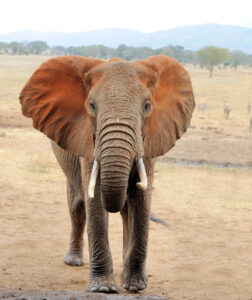Elephants are some of the most fascinating creatures in the animal kingdom. They are the largest land animals on Earth and possess an intricate communication system that combines body language, vocalizations, and infrasound. In this section, we will take a closer look at how elephants communicate with each other in the wild, uncovering the mysteries of their language and the significance of their various vocalizations.
Key Takeaways
- Elephants possess a unique communication system that combines body language, vocalizations, and infrasound.
- Their communication methods have evolved over millions of years, adapting to their changing environments and social dynamics.
- Elephants use a variety of vocalizations such as trumpets, rumbles, and roars to convey different messages.
- Infrasound plays a significant role in elephant communication, allowing them to communicate over long distances.
- Observing elephants in the wild provides valuable insights into their communication patterns.
Understanding Elephant Body Language
When it comes to communicating with each other, elephants have a lot to say without ever uttering a word. Their social behavior is complex, and their use of body language is a critical part of it. As we venture deeper into the world of elephant communication, we can start to understand their gestures and postures, which they use to convey important messages.
Elephants have an incredible memory, so they can recognize other elephants they have met in the past. When they greet each other, they wrap their trunks around and intertwine them, which is a universal sign of friendship. They also use their trunks to touch each other's face, ears, and mouth to convey messages of reassurance or dominance.
Another crucial aspect of elephant body language is their posture. Dominant elephants will often stand tall and hold their head high, while a submissive elephant will keep its body lowered and its head down. When elephants are about to charge, they tuck their ears back, flare their nostrils, and hold their trunks straight out.
But the most awe-inspiring aspect of elephant body language is their use of movement to communicate. They sway their trunks to show excitement, and when they are angry, they stomp their feet and swing their trunks. Elephants also use their trunks to gesture towards something of interest, like water or food.
Understanding elephant body language is crucial to learning about their social behavior and communication methods. The next time you see a group of elephants, take a moment to observe their gestures and postures, and you might be surprised at how much they have to say without ever making a sound.
Decoding Elephant Vocalizations
Now, we come to the vocalizations of the majestic elephants. Did you know that they make over 10 types of vocal sounds? Yes, you read that right!
Their trumpets – which sound like a loud blaring horn – are the most distinctive. These are used to express excitement, aggression, or fear. Their greeting call is another fascinating vocalization, a low-frequency rumble that elephants use to say ‘hello' to each other. It's almost like an elephant handshake!
Then there are the roars, which are produced during conflicts to intimidate opponents. The snorts and grunts are usually sounds of frustration or annoyance, while the low-frequency rumbles are used to bond and communicate over long distances. Their communication methods are truly diverse, and it's amazing how they use each of these vocalizations to convey different messages.
But wait, that's not all. Did you know that elephants also use their vocalizations to differentiate between human languages? Yes, they can distinguish between various languages based on their unique sounds. If that isn't impressive, we don't know what is!
Elephant vocalizations are a vital part of their communication methods. From warning each other of danger to communicating over long distances, these vocal sounds are just as important as their body language and infrasound.
We can't help but marvel at the sheer complexity of elephant communication. It's almost like they have their own language, and we are only beginning to understand it.
The Role of Infrasound in Elephant Communication
Now, let's talk about the elephant in the room – infrasound! Did you know that elephants can communicate with each other over long distances using sounds that are too low for humans to hear? That's right, they produce infrasounds that can travel up to several miles, allowing them to stay in touch with other members of their herd even when they're out of sight.
But what exactly are infrasounds? They are low-frequency vibrations produced by various parts of the elephant's body, including their vocal cords, trunks, and even their feet. These sounds can range from 1 to 20 Hz, which is below the range of human hearing (20-20,000 Hz). In fact, some scientists believe that elephants can produce sounds as low as 1 Hz, making them the only land animals capable of doing so!
So, how do elephants use infrasounds to communicate? Research has shown that different types of infrasounds convey different messages. For example, elephants use rumbling sounds to signal distress or to call for help. They also produce trumpets, roars, and grunts to communicate aggression, fear, joy, or excitement.
Interestingly, elephants can also use infrasound to sense their surroundings. They can detect vibrations from other elephants, as well as the location and distance of objects such as water sources and potential predators. This makes infrasound not only a tool for communication but also a means of survival in the wild.
The use of infrasound is just one example of how elephants have evolved complex communication methods to navigate their social and physical environments. Now that we've uncovered the mysterious world of infrasound communication, let's explore how elephants use their language and vocalizations in the wild.
Elephant Communication in the Wild
When we observe elephants in their natural habitat, we can gain valuable insights into their social behavior and communication patterns. For instance, did you know that elephants use low-frequency vibrations in the ground to communicate over long distances?
The communication between elephants is particularly important during foraging, which is a significant activity that helps them to maintain their formidable size and also survive in harsh conditions. It is fascinating to watch how elephants use their trunks not only to gather food but also to communicate with one another.
During mating, the males often use vocalizations to announce their presence and compete for a female's attention. Meanwhile, the females engage in a complex system of body language and vocalizations to express their readiness to mate.
The protection of the young is also a crucial factor in elephant social behavior. When a calf is in danger, the entire herd works together to defend it. Elephants may use trumpets and roars to intimidate predators and warn the herd of potential danger. These vocalizations also serve to communicate a sense of unity and cooperation within the group.
In summary, observing elephant communication in the wild is truly remarkable. We have witnessed how the use of body language, vocalizations, and other forms of communication play a critical role in elephant social behavior. It is no surprise that these majestic animals have captured our imaginations for centuries.
The Evolution of Elephant Communication
Now, let's take a trip back in time to explore how elephant communication has evolved over millions of years. We know that elephants have always been highly social creatures, living in tight-knit family groups and communicating with each other in a variety of ways.
Some scientists believe that elephant communication may have started with simple vocalizations, such as grunts or snorts, which over time evolved into more complex sounds and a unique language. Others suggest that it was their body language that first facilitated communication, allowing elephants to convey messages through their movements and gestures.
Whatever the origins, we know that elephant communication has adapted and evolved over time to meet the needs of their changing environments and social dynamics. For example, elephants in the savannahs of Africa may use different vocalizations than those in the dense forests of Asia, and communication patterns may vary depending on the size and composition of the social group.
One fascinating aspect of elephant communication is that they seem to have the ability to learn new sounds and adapt their language to new situations. Researchers have observed elephants in captivity developing unique vocalizations that are not found in the wild, suggesting that their communicative abilities are not fixed but can be influenced by their environment and experiences.
Overall, the evolution of elephant communication is a testament to the complexity and adaptability of animal communication. By understanding how elephants communicate, we gain a deeper appreciation for the intelligence and social dynamics of these magnificent creatures.
The Thrilling Journey of Elephant Communication
Throughout this article, we have explored the wonders of elephant communication. From decoding their unique language to understanding their body language, we have uncovered a world of complex social dynamics that exists within elephant herds.
Through the use of various vocalizations and infrasound, elephants are able to communicate across long distances, establish hierarchy, and protect their young. Their communication methods have evolved over millions of years, adapting to changing environments and social dynamics, resulting in a rich and intricate system of communication.
Understanding elephant communication not only deepens our appreciation for these majestic creatures, but also offers insight into the complexities of animal communication as a whole. We hope that this journey through the wild has been as thrilling for you as it has been for us, and that you have gained a newfound respect for the incredible communication abilities of elephants.
Frequently Asked Questions
How do elephants communicate?
Elephants have a unique language and communicate through various vocalizations, body language, and infrasound.
What are some examples of elephant body language?
Elephant body language includes gestures, postures, and movements that help them convey messages and establish hierarchy within their social groups.
What are the different vocalizations elephants use to communicate?
Elephants communicate through trumpets, rumbles, roars, and other vocal sounds, each with its own meaning and significance.
What is infrasound and how do elephants use it to communicate?
Infrasound refers to the low-frequency sounds produced by elephants that are below the range of human hearing. Elephants use infrasounds to communicate over long distances and maintain their social structure.
How do elephants communicate in the wild?
Observing elephants in their natural habitat allows us to see how they utilize their language and vocalizations in various activities such as foraging, mating, and protecting their young.
How has elephant communication evolved over time?
Elephant communication has evolved over millions of years, adapting to changing environments and social dynamics. Understanding its development gives us insight into the complexities of animal communication.





